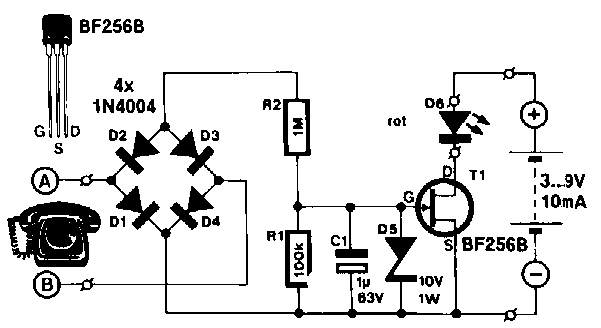
Rf Output Indicator

A simple RF detector circuit utilizing a visual indicator can serve as an RF output indicator. This circuit was designed for use as a transmitter ON indicator.
The RF detector circuit typically consists of a few key components: a diode, a resistor, a capacitor, and an LED. The diode acts as the primary sensing element, converting the RF signal into a DC voltage. This process is known as rectification. The output from the diode is then filtered using a capacitor, which smooths out the rectified signal, allowing for a stable voltage level that can be used to drive the visual indicator.
In this configuration, the resistor is connected in parallel with the LED to limit the current flowing through it, ensuring that the LED operates within its specified current range. The LED serves as the visual output, illuminating when an RF signal is detected, thus indicating the presence of RF energy.
The circuit can be powered by a low-voltage power supply, and the sensitivity can be adjusted by varying the values of the resistor and capacitor. This RF detector circuit is particularly useful in applications where monitoring RF output is critical, such as in transmitter systems, ensuring that operators can easily determine the operational status of the transmitter through a simple visual cue.
Additionally, the circuit can be enhanced by incorporating a variable gain amplifier to improve sensitivity or by using a microcontroller to process the signal further, providing more detailed information about the RF output. Overall, this RF detector circuit is a practical solution for visual RF signal indication. A simple RF detector circuit using a visual indicator can be useful for an RF output indicator, etc. This circuit was u sed for a transmitter ON indicator.
The RF detector circuit typically consists of a few key components: a diode, a resistor, a capacitor, and an LED. The diode acts as the primary sensing element, converting the RF signal into a DC voltage. This process is known as rectification. The output from the diode is then filtered using a capacitor, which smooths out the rectified signal, allowing for a stable voltage level that can be used to drive the visual indicator.
In this configuration, the resistor is connected in parallel with the LED to limit the current flowing through it, ensuring that the LED operates within its specified current range. The LED serves as the visual output, illuminating when an RF signal is detected, thus indicating the presence of RF energy.
The circuit can be powered by a low-voltage power supply, and the sensitivity can be adjusted by varying the values of the resistor and capacitor. This RF detector circuit is particularly useful in applications where monitoring RF output is critical, such as in transmitter systems, ensuring that operators can easily determine the operational status of the transmitter through a simple visual cue.
Additionally, the circuit can be enhanced by incorporating a variable gain amplifier to improve sensitivity or by using a microcontroller to process the signal further, providing more detailed information about the RF output. Overall, this RF detector circuit is a practical solution for visual RF signal indication. A simple RF detector circuit using a visual indicator can be useful for an RF output indicator, etc. This circuit was u sed for a transmitter ON indicator.





